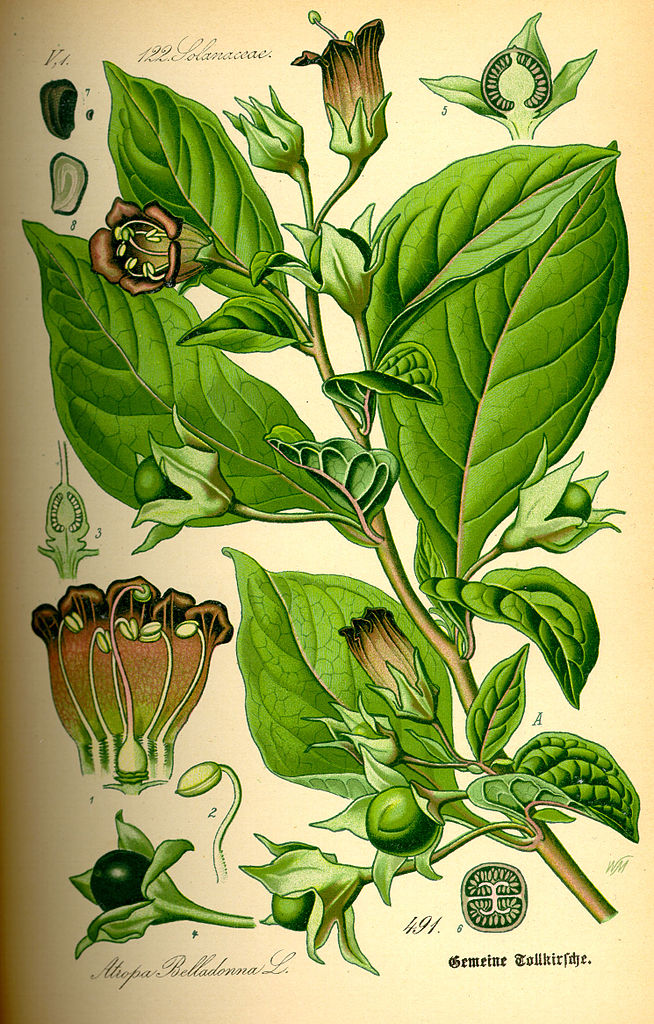
Scientific Name Atropa belladonna
Common Name Belladonna, Deadly Nightshade
Botanical Family Solanaceae
A. belladonna is the plant that Dorian Gray had Vanessa smell and describe in S1E4 as they walk through a botanical garden greenhouse. The genus name comes from Atropos, who was 1 of the 3 goddesses of fate or destiny in Greek mythology. Atropos was the oldest of the 3 goddesses, and known for her inflexibility and her inevitability. The name bella donna comes from the Italian for “pretty woman” or “beautiful lady”, because the herb was used to dilate the pupils of women’s eyes for cosmetic purposes, something that Madame Kali mentions in season 2. The plant is a herbaceous perennial, native to Europe, North Africa, and Western Asia.
It is one of the most toxic plants found in the Eastern Hemisphere, as it has tropane alkaloids in all parts of the plant. The symptoms of belladonna poisoning include dilated pupils, sensitivity to light, blurred vision, tachycardia, loss of balance, staggering, headache, rash, flushing, severely dry mouth and throat, slurred speech, urinary retention, constipation, confusion, hallucinations, delirium, and convulsions.
The plant was used at one time for cosmetic purposes, but due to its toxicity, it is no longer commonly used for that purpose. Putting A. belladonna in the eyes to dilate the pupils, would over time, lead to blindness, and possibly, death. Medicinally, A. belladonna has been used for centuries as a pain reliever, muscle relaxer, and inflammatory mediation, among many other common ailments. There is at least one surviving example of the prepration of A. belladonna to use on a patient, from a 19th century eclectic medicine journal.
“Take of recently dried Belladonna leaves, four ounces; Diluted Alcohol, two pints. Macerate for fourteen days, express, and filter through paper…Dose, ten to thirty drops.” From Officinal Preparations by Joseph R. Buchanan and R.S. Newton (1854).
The above description is on how to make a Belladonna tincture, which is typically an alcoholic extract of plant or animal material. The tincture would be prepared and then drank.
Atropa belladonna and related plants, such as jimson weed have been occasionally used as recreational drugs because of the vivid hallucinations and delirium they produce. However, the hallucinations are often considered to be highly unpleasant, and the use extremely dangerous, because it is easy to overdose.
Folklore
Within folklore, Belladonna is associated with witches, who would supposedly mix the plant with other toxic and poisonous plants and apply the mixture to themselves, to make a flying ointment, which would enable them to fly their gatherings. These flying ointments were typically made out of hallucinogenic plants and herbs. Apparently, the practice of making flying ointment was documented by Alice Kyteler, the first recorded person condemned for witchcraft in Ireland in 1324.
“In rifleing the closet of the ladie, they found a Pipe of oyntment, wherewith she greased a staffe, upon wich she ambled and galloped through thick and thin, when and in what manner she listed” From Stairways to Heaven: Drugs in American Religious History by Robert C. Fuller.
Sometimes the Belladonna was combined with opium poppy to create this flying ointment, and some scholars have argued that the true use of this ointment was to create a dream-like waking state. The combination of opium poppy and Belladonna would have created this state, because of the antagonism between tropane alkaloids and opiate alkaloids.
References
Cummins BM, Obetz SW, Wilson MR (June 1968). “Belladonna poisoning as a facet of pschyodelia”. JAMA204 (11): 1011. doi:10.1001/jama.204.11.1011.PMID 5694682
“Belladonna.—Belladonna”. Henrietta’s Herbal. Retrieved 2008-07-08.
Joseph R. Buchanan, R.S. Newton (1854). Wm. Phillips and co., ed. “Officinal preparations”. The Eclectic Medical Journal (Wm. Phillips and co.)
Kuklin, Alexander (February 1999). How Do Witches Fly?. DNA Press.